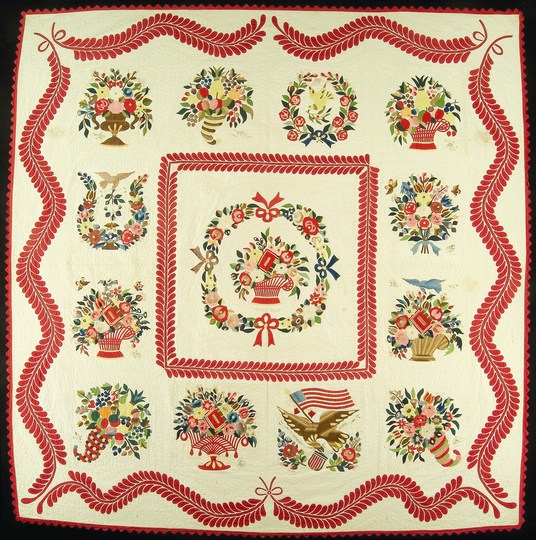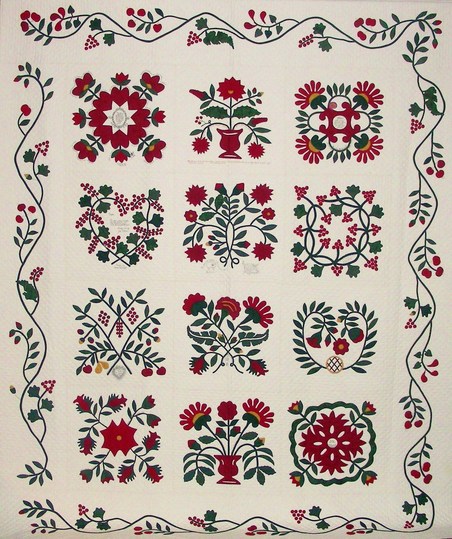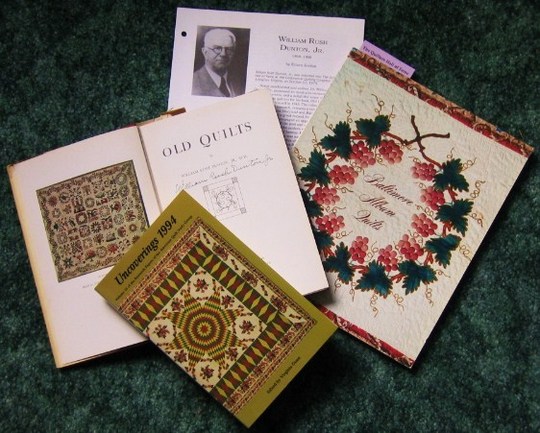William R. Dunton
(1868-1966) Quilt Collector, Author, Psychiatrist
It's hard to realize just how many years have passed since I saw my first exhibit of Baltimore Album Quilts at the Baltimore Museum of Art in the early 80s. I was new to quilting at the time but loved appliqué and was stunned by these beauties and intrigued by their history. I would soon learn that the first person to research and document this particular style of quilt was male and among the first 5 people inducted into The Quilters Hall of Fame in 1979 - Dr. William Rush Dunton of Baltimore.

1997.007.0319, International Quilt Study Center, UNL, www.quiltstudy.org To access more traditional Baltimore Album quilts in the IQSC collecton, see end of article.
Born in Pennsylvania in 1868, Dr. William R. Dunton was psychiatrist at Sheppard-Pratt Asylum in Baltimore for many years in the early part of the 20th century, had a long association with Johns Hopkins University as an instructor in psychiatry and was a founding member of three professional societies within his field. Bunnie Jordan's chapter on Dunton in the book "The Quilters Hall of Fame" goes into interesting detail about his professional career as a psychiatrist as well as an occupational therapist. In fact, he wrote the first complete textbook on occupational therapy and is often called the "father of occupational therapy". How very appropriate that the "father" of occupational therapy would include quilting from the very beginning of his exploration of the benefits of occupational therapy! Today many millions of women (and men) know of quilting's many emotionally satisfying benefits.
Dunton is said to have been influenced by his mother's love of needlework for in 1877, the year of its founding, she was an early pupil at the Philadelphia School of Art Needlework. However, he acknowledges in the introduction to his book Old Quilts that he can recall no quilt in his home as a boy and speculates "their making was too unfashionable in large cities to interest many during the 1870s." However, much later in life when he came across a long forgotten box in his own closet, he wrote, "a tea box of diamonds of colored silks in which I recognize some of my childhood neckties...and I believe I assisted in cutting these."
Dunton credits TQHF Honoree Marie Webster's 1915 book Quilts: Their Story and How to Make Them with awakening his interests in documenting and recording early quilts and their history, although he writes, "it seems that I must have had an interest before that time or I should not have wanted to read the book." He also quickly realized that the process of selecting color and pattern, as well as the social interaction that quilts traditionally engendered, would be of great benefit to his "nervous" patients. As a psychiatrist, he thought his female patients could benefit from the quiet calming influence of needlework as well as the sense of accomplishment it brought.

Circa 1850 MD Album Quilt (Copake Annual Textile Auction07-sold June 30, 2007)
Although Dunton did not focus exclusively on needlework as a fitting from of occupational therapy for his patients, quilts took on a special meaning for him personally. Or, more specifically, the documentation and collecting of quilts took on a new meaning for him and quickly became one of his many personal interests after he fell under their spell and began a correspondence with Marie Webster, soon after her book was published in 1915. Eventually he would correspond with a small cadre of quilt scholars who undoubtedly encouraged him to publish his own book. Unable to find a publisher willing to take on his book, Dunton self-published 2,000 copies. Every book is hand-numbered and today copies command a hefty price in the market place, if you can even find one.
From our perspective today, we find it rather amazing that any male, but perhaps especially a psychiatrist, would be planning and executing a quilt exhibit in 1916. But on September 5, 1916, when Dunton held his first quilt exhibit for his patients, he would in fact exhibit 50 quilts-quilts borrowed from the families of patients and friends, as well as three loaned by Marie Webster herself. Dunton would go on to curate three quilt exhibits for the Baltimore Museum of Art as well, with the 1944 exhibit featuring the quilts that had come to intrigue him the most - Baltimore Album Quilts.

Members of the Baltimore Applique Society made tracings of the original
Mary Mannakee quilt that resides in the collection of the Daughters of
the American Revolution and then made a reproduction quilt which was
raffled to raise money for the DAR. Marylou McDonald, Past President of
the BAS, and her stitch group, called Friends from the Heart, also decided
to exchange blocks made from these tracings. Marylou made one block
(top row, far right) and the borders. In early 2002, the finished quilt top
was sent to a quilter in Kentucky to hand quilt.
Dunton is perhaps more responsible than any other early quilt historian for documenting quilts that had a special affiliation with the Baltimore area. His groundwork research on this style helped later quilt historians trace the influence of the Baltimore -style as it evolved and made its way into other regions. However, the research Dunton did covered much more than just this one style.
Dunton was a meticulous record keeper and archivist. In the late 50s to early 60s his extensive collection of research materials and photographs was donated to the Baltimore Museum of Art. The Baltimore Applique Society, founded in 1993, raised $5,600 in 1997 towards stabilizing the Dunton papers so that they could be made available to researchers. This passionate group of applique-lovers and quilt historians continues to support the preservation of the Dunton archival material as well as the Baltimore Album quilts in more than one museum collection.

Photo courtesy of Karen Alexander. Beginning at top: Dunton Article from TQHF
Honoree book, Katzenberg book, AQSG's Uncoverings 1994, Dunton book bearing
his signature.
In 1980 Dena Katzenberg created an exhibit of 50 Baltimore Album quilts and produced a thoroughly researched catalogue. Out of print very quickly, the catalogue continues to command a high price. The point I am making is that the exhibit traveled and created such a national awareness of Baltimore Applique quilts at the time that prices soared, bringing more and more quilts out of family closets so more and more of the old beauties began to be documented.
Jennifer Gloldsborough's presentation at the 1994 AQSG seminar in Birmingham, AL, shed additional new light on this genre of quilt and is well worth studying. The Baltimore Album style continues to enjoy a strong resurgence among quiltmakers today thanks to the many new teachers. Elly Sienkiewicz of Maryland, with her many books, is perhaps the most well known. Somewhere in the depths of all my quilt history files, I have a photo of Elly from the early 1980s in our guest room, cuddled under one of her spectacular applique quilts that featured her daughter.
Speaking of early quilt historians, Dunton mentions the work of five women- in additions to Marie Webster- who furthered his own education about quilts and suggested these authors could do the same for his readers: Florence Peto (see article here), Ruth Finley (see article here), plus Ruby McKim, Carrie Hall, and Rose Kretsinger, who will be covered in future articles. (Peto was in touch with Carrie Hall and Rose Kretsinger, though I am unaware if Dunton ever had direct contact with these last two Honorees.)
Be sure to keep up with the doings at The Quilters Hall of Fame via our blog or website. Meanwhile, keep those needles flying and spread the word about how quilts enrich your life and the life of our communities!
Karen Alexander
Past President, The Quilters Hall of Fame
Member of AQSG since 1981
Of Note:
Be sure to visit the International Quilt Study Center's Collections Database here to see more Baltimore Album quilts. There are several ways to query the database and how one does it determines, of course, the results. If you enter only "album" as a pattern or keyword, you will get ALL album quilts, not just Baltimore. If you enter "Baltimore" in keyword you only get the Baltimore Albums plus other quilts with Baltimore origins. The latter does give you fewer, and does include the Baltimore Albums. The images retrieved by the Collections Database are low resolution, not "zoomable".
The second way to see the IQSC quilts is via Quilt Explorer here. There are fewer quilts in this area. However, they are all high resolution; therefore you may zoom in for great details. If you search by "Style/Type" and select Baltimore Album, there are three gorgeous quilts in high res. Note that when you start to zoom in on one of these images you may drag the image around with your mouse to see all parts of the quilt close-up, a dandy little feature.
The Quilt Index here, sponsored by the Alliance for American Quilts, is another great place to see Baltimore Album quilts and their derivatives and you search it in a very similar way as the IQSC's data base.
Bibliography:
Debby Cooney, "A Legacy Revised: New Access to Dr. Dunton's Work" in Blanket Statements, Issue 55, Winter 1998/99, (Lincoln, NE: American Quilt Study Group)
William Rush Dunton, Jr., MD, Old Quilts (Baltimore: Privately printed, 1946)
Jennifer F. Goldsborough, "An Album of Baltimore Album Quilt Studies" in Uncoverings 1994, ed. Virginia Gunn (San Francisco, CA: American Quilt Study Group)
Eileen (Bunnie) Jordan, "William Rush Dunton, Jr.", The Quilters Hall of Fame, ed. Merikay Waldvogel and Rosalind Webster Perry (Marion, IN - The Quilters Hall of Fame, 2004)
Eileen Jordan, "Dunton Papers Available Soon", in The Quilters Hall of Fame Newsletter, No. 14, Fall 1998 (Marion, IN: The Quilters Hall of Fame)
Dena S. Katzenberg, Baltimore Album Quilts (Baltimore: the Baltimore Museum of Art, 1981)
Elly Sienkiewicz, Baltimore Beauties and Beyond (C&T Publishing, 1989)




.jpg)



RSS feed for comments to this post